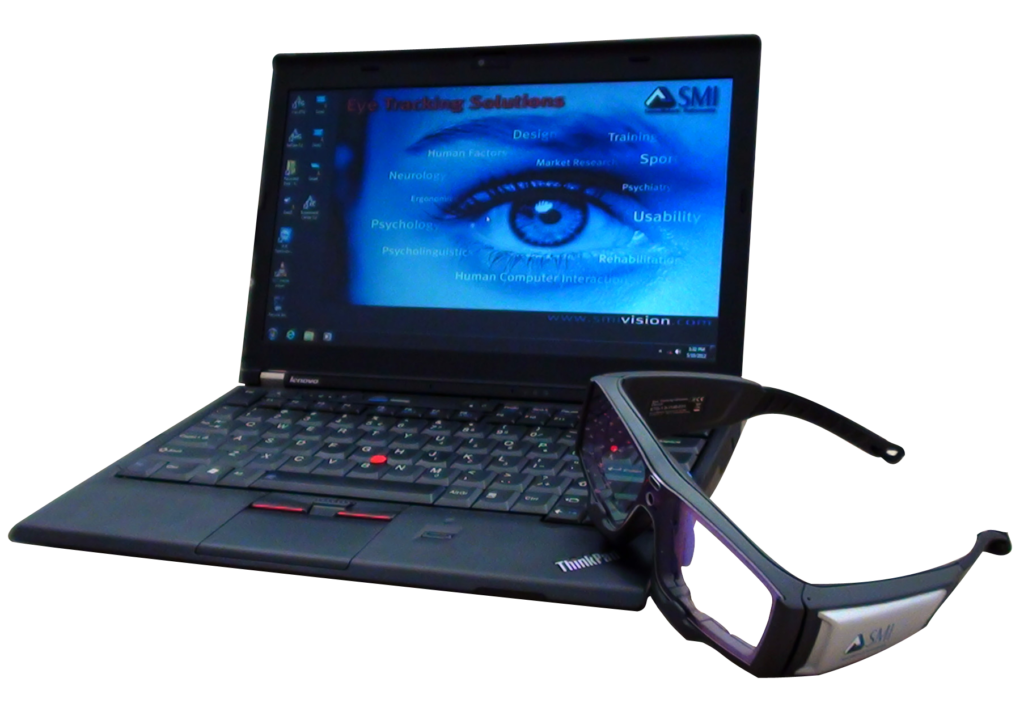Mobile eye tracking device - SMI Eye Tracking Glasses

SMI Eye Tracking Glasses is a device designed to analyze visual perception in a real and virtual environment (for example driving simulators). The device uses a non-contact optical method, which consists in examining the position of the infrared light reflection from the eye’s cornea in relation to the center of the pupil. The Glasses system is built on the basis of glasses. It also has automatic parallax error compensation which ensures highly accurate results at any distance (no manual adjustment necessary). SMI glasses have the option of replacing corrective lenses, and therefore can be used to examine people with visual impairments. The system operates in binocular mode, i.e. both eyes are monitored simultaneously.
The eye tracking device allows you to test the user’s visual activity. The parameters most often measured in the study of visual activity are the so-called fixations and saccades. Fixation means holding the test person eyesight on an element or area. This process should last more than 200 ms. It is assumed that fixations are associated with prioritizing elements in terms of the field of view, as well as with their cognitive analysis. A saccade is a shift of eyesight from one fixation to the next. This is one of the fastest eye movements, lasting 30 ms to 80 ms. During this movement, the human does not register the elements in its path, but only changes the analysis area from the area at the start point to the area at the end point. The path of a saccade is rarely the shortest path between the start and end points. It usually takes the shape of a curve.
There are also other eye movements measured by eye tracking device, such as glissades, microsaccades and eye tremors, however, due to the examination of drivers’ attention, they appear to be less important than fixations and saccades.
The use of the mobile SMI Eye Tracking Glasses enables the registration of the parameters of the driver’s visual attention during the journey in real traffic.
This eye tracking device records the eye image with a sample rate of 30 Hz, and the contextual image with a sample rate of 24 Hz (resolution of 1280 × 960 points), has a resolution of 0.1°, an accuracy of 0.5° and a registration area of 80° horizontally and 60° vertically.
Technical specification for the mobile SMI Eye Tracking Glasses.
Function | Value / unit |
Sampling rate | 30 Hz |
The method of collecting eye tracking data | pupil/CR, dark pupil tracking |
Eye Tracking Principle | Binocular eye tracking with automatic parallax compensation |
Gaze position accuracy | 0.5°over all distances, parallax compensation |
Gaze tracking range | 80° horizontal, 60° vertical |
Scene camera | Resolution: 1280 x 960p – 24 FPS |

The SMI ETG mobile eye tracking device uses the technology of “intelligent” image analysis, has sufficient accuracy (angular resolution up to 0.5°) and frequency (30 Hz), the necessary mechanisms (automatic parallax compensation, “post factum” calibration, etc.) and parameters not limiting research (the device is built into the glasses weighing 75 g), which are required for the needs of the proposed solution. The device measures two factors – the spots of infrared light reflection from the eye lens and the center of the pupil of the eye – and then, based on the relationship of these parameters, it determines the point of eyesight concentration, presenting it on the image of the contextual camera (also installed in the system’s glasses). The software dedicated to this device allows for almost fully automatic video image processing and allows to calculate the statistical results of the tested sample of people. The measured parameter in the research will be, first of all, fixations, which define the duration of the eyesight concentration (gaze) in a specific area. According to the basic theory of eye tracking, it is assumed that fixation is approximately a measure of the subject’s focus on the observed object. The measure of fixation is the observation time of the object. Thus, specific solutions will be assessed mainly in terms of their impact on the course of the driver’s cognitive functions.

